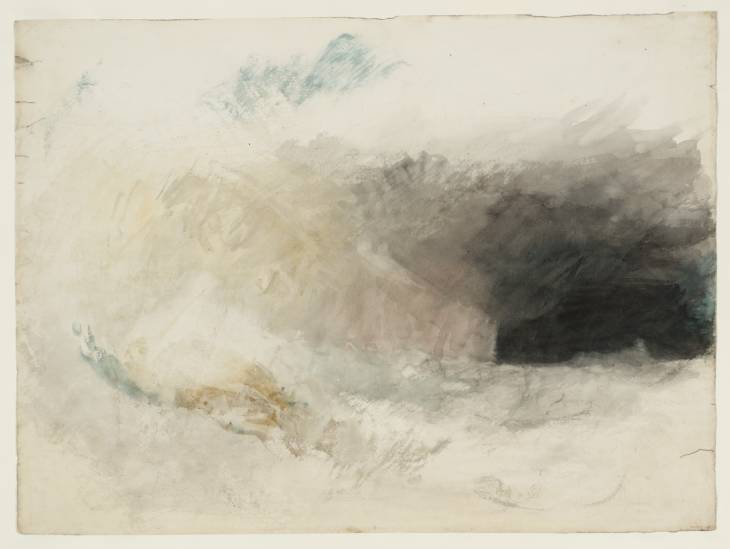Joseph Mallord William Turner Longships Lighthouse, Land's End, from the North-East c.1834
Joseph Mallord William Turner,
Longships Lighthouse, Land's End, from the North-East
c.1834
Joseph Mallord William Turner 1775–1851
Longships Lighthouse, Land’s End, from the North-East c.1834
D36323
Turner Bequest CCCLXV 32
Turner Bequest CCCLXV 32
Watercolour on white wove paper, 428 x 580 mm
Stamped in black ‘CCCLXV – 32’ bottom right
Stamped in black ‘CCCLXV – 32’ bottom right
Accepted by the nation as part of the Turner Bequest 1856
Exhibition history
1931
Display of Watercolours from the Turner Bequest, lent from the British Museum, National Gallery, Millbank [Tate Gallery], London, 1931–March 1934 (no catalogue).
1997
Turner’s Watercolour Explorations 1810–1842, Tate Gallery, London, February–June 1997, Southampton City Art Gallery, June–September 1997 (69, reproduced, as ‘Longships Lighthouse, Land’s End, from the North-East’, ?c.1834).
2011
William Turner. Maler der Elemente / Turner and the Elements, Bucerius Kunst Forum, Hamburg, June–September 2011, Muzeum Narodowe, Krakow, October–January 2012, Turner Contemporary, Margate, January–May 2012 (32, reproduced in colour, as ‘The Longships Lighthouse, Land’s End, from the North-East’, ?c.1834).
References
1909
A.J. Finberg, A Complete Inventory of the Drawings of the Turner Bequest, London 1909, vol.II, p.1214, CCCLXV 32, as ‘Cliffs, with stormy waves’, after about 1830.
1997
David Hill, ‘Turner’s “Colour Beginnings” in Britain’, Turner Society News, no.76, August 1997, p.7.
1997
Eric Shanes, Turner’s Watercolour Explorations 1810–1842, exhibition catalogue, Tate Gallery, London 1997, pp.18, 80, 97, 98, 107 (p.80 no.69, reproduced, as ‘Longships Lighthouse, Land’s End, from the North-East’. ?c.1834, p.97 Appendix I under ‘England and Wales Series’, as ‘Sketch for a view of Land’s End and the Longships Lighthouse from the northeast’. ?c.1834, p.98 under ‘Land’s End, Cornwall’, as ‘Sketch for a view of Land’s End and the Longships Lighthouse from the north-east?’. c.1834, p.107 Appendix II, as ‘Sketch: Land’s End from the north-east?’).
The present work is one of eight ‘colour beginnings’ catalogued here as Land’s End subjects; the others are Tate D25129, D25163, D25165, D25172, D25274, D36324 and D36326 (Turner Bequest CCLXIII 7, 41, 43, 50, 152, CCCLXV 33, 35). A further colour study has been proposed as a Land’s End view among other possibilities (Tate D25185; Turner Bequest CCLXIII 63). For Turner’s 1811 pencil sketches at Land’s End, see under D25129.
Eric Shanes has described this view as one in which Turner ‘tested opposed offshore viewpoints’1 for his watercolour Longships Lighthouse, Land’s End of about 1834 (J. Paul Getty Museum, Los Angeles),2 engraved in 1836 for the Picturesque Views in England and Wales (no impressions held at Tate); it is ‘almost a mirror image’3 of the finished design.
The composition is loosely comparable to Lands End, Cornwall, with Long-ships Light-house, an 1814 engraving after Samuel Owen (Tate impressions: T05434, T05435) published in the Picturesque Views on the Southern Coast of England, to which Turner contributed the untraced watercolour Land’s End, Cornwall: Approaching Thunderstorm of about 1813,4 also engraved in 1814 (Tate impressions: T04373, T04374, T05426–T05433, T05963). Owen’s composition is taken looking south-west from a clifftop viewpoint, with the lighthouse consequently much higher on the horizon compared with Turner’s sea-level view here; Turner’s only drawing from this direction in the Cornwall and Devon sketchbook (Tate D41301; Turner Bequest CXXV a 25) is very similar to Owen’s view, so the present study with its lower viewpoint presumably relied partly on Turner’s imagination.
David Hill has described the status of Shanes’s identification as ‘not proven or positively dubious’.5
See also the introductions to the present subsection of identified subjects and the overall England and Wales ‘colour beginnings’ grouping to which this work has been assigned.
Verso:
Blank
Blank
Matthew Imms
March 2013
How to cite
Matthew Imms, ‘Longships Lighthouse, Land’s End, from the North-East c.1834 by Joseph Mallord William Turner’, catalogue entry, March 2013, in David Blayney Brown (ed.), J.M.W. Turner: Sketchbooks, Drawings and Watercolours, Tate Research Publication, December 2013, https://www

